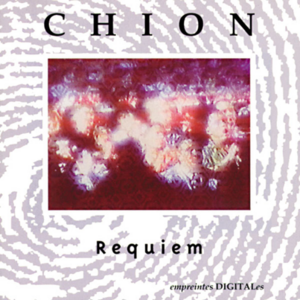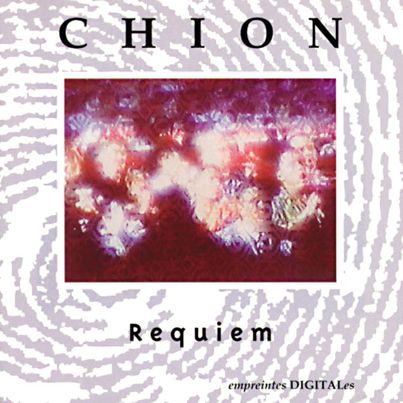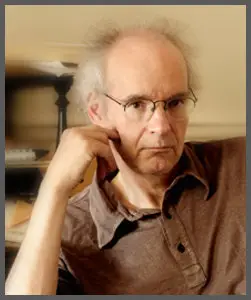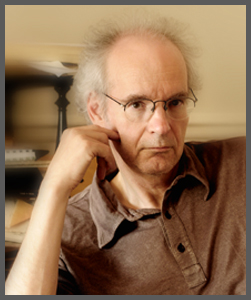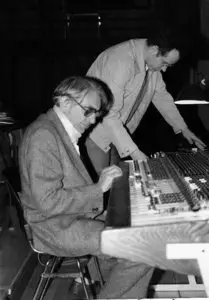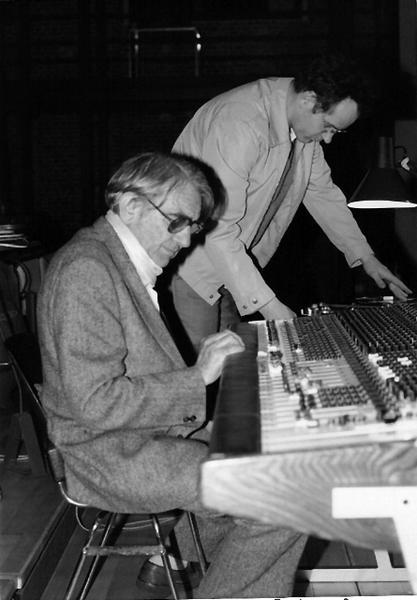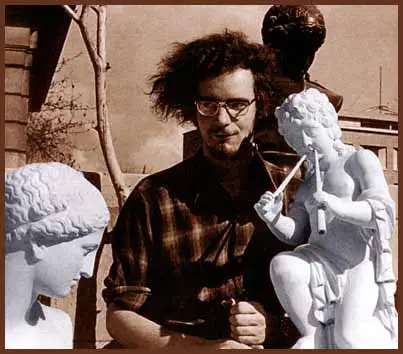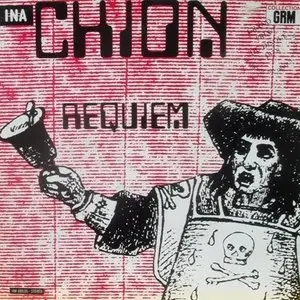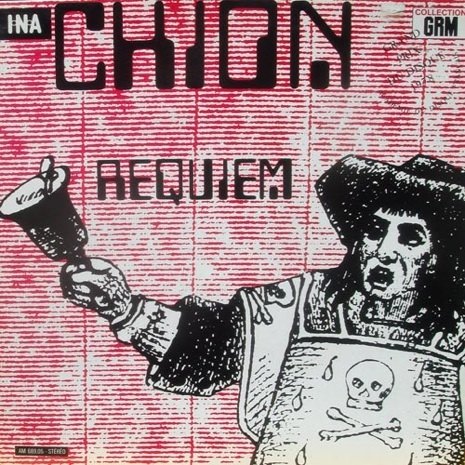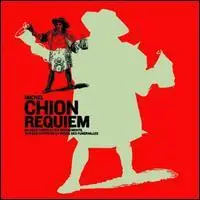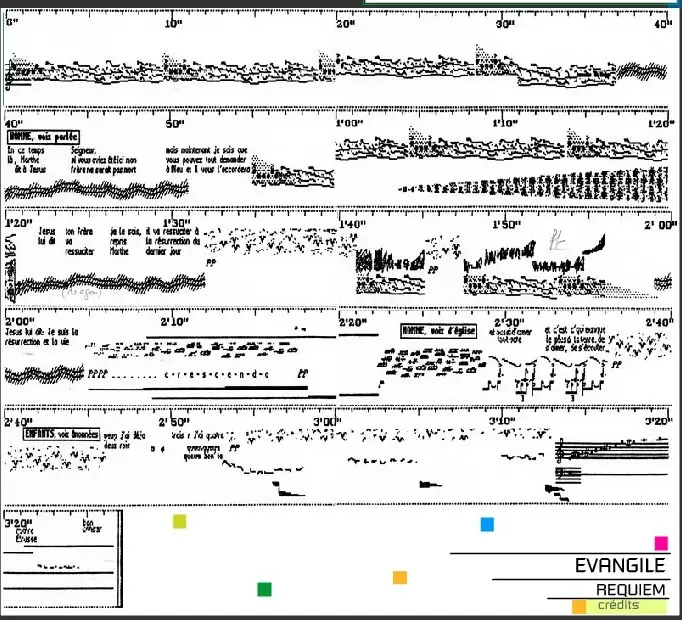Michel Chion – Requiem
XLD | FLAC+CUE, LOG | 325.1 MB | Complete Scans | 45.6 MB | RAR
Contemporary Music / Avant-garde / Musique concrète
1 CD | Label : empreintes DIGITALes | IMED 9312 | UPC / EAN 771028931224 • Ina-GRM
XLD | FLAC+CUE, LOG | 325.1 MB | Complete Scans | 45.6 MB | RAR
Contemporary Music / Avant-garde / Musique concrète
1 CD | Label : empreintes DIGITALes | IMED 9312 | UPC / EAN 771028931224 • Ina-GRM
"The was composed whilst thinking about the troubled minority of the living rather than the silent majority of the dead." "With my intention was not to deliver a message or a manifesto, whether pro- or anti-religious. Instead, this work is a personal testimony, into which listeners are invited to project their own self, if they care to inhabit it with their own experience and sensibility."Michel Chion. Booklet
by Tom Schulte in (USA), July 1, 1999 » 313_001 Chion began splicing together tape making musique concrète in France in the 1970s. The title track () to this collection of pieces is a 37:16 dark, mysterious and at times demented version of the classic Funeral Mass. Funeral Mass is the basis for all classical requiems. While such classic requiems glorify in the suggestion of eternal life suggested by the religious interpretation of death, Chion’s work is probes the existential panic of those living under the threat of death. A dark, kaleidoscope collage of cruel whispers, snippets of choral works and eerie, segmented sacred string music promote a feeling of uneasiness and abandonment. (10:02) finds Chion still working creatively with tape in the late 80s and 1990. An odd, transmogrified waltz is the underlying theme to this series of sonic portraits separated by silent periods. (Black Night) (22:14) precedes Variations chronologically and is dedicated to American science fiction writer Philip K. Dick (, , ). This nightmare sequence is an aural re-enactment of a sleepless night of terror. Creaking, groaning and things that go bump in the night cavalcade through this unsettling work. (4/5) by George Zahora in (USA), December 7, 1998 » 289 contains three classic musique concrète compositions from Michel Chion. All were produced at the GRM in Paris (the acousmatic headquarters of the world). The itself is an electronic take on the traditional form. is a ‘technical study’ which takes an original waltz theme and fragments it. is considered a ‘monodrama’ — that is, a drama centering around one ‘character.’ In this case what we hear are the detached reactions of this ‘character’ to a nightmare. It’s French, it’s acousmatic… what more could you ask for?
Review
by Laurie Radford in CEC, Contact! #9:1 (Canada), September 1, 1995 » 200
The twelfth release from empreintes DIGITALes (which now boasts a catalogue of twenty one CDs exemplifying the diversity of the electroacoustic arts) is a collaboration with GRM, and is one of a number of recent projects involving international electroacoustic artists. This disc is of special note since the principal work, , was first presented on vinyl by GRM in the year of its completion and premiere in 1973. Chion is a senior French electroacoustic composer and one of the art’s principle theoreticians advocating a return to the noncausal principles at the origin of musique concrète, and composes rigorously in this style. He has a large and diverse œuvre dating back to the sixties including many large scale ‘concrete melodramas’ such as and . , based upon the text for the Mass for the Dead, presents an array of ‘testimonies’ from various voices in ten movements over the course of 37 minutes. The blending and rapid juxtaposition of electronic sounds, environmental soundbites, a myriad of vocal styles and contexts presenting texts heavy with centuries of meaning, creates a lurching and sometimes startling dramatic course which runs the gamut from the maniacal to the transcendantal final movement, . The mosaic-like Variations which follow arise from a period of technical studies undertaken by Chion in the late 1980’s. Constantly changing blocks of contrasting materials anchored by a short waltz theme, develop into a reflection and “affirmation of the whirlwind of life.” The final work on the disc, , is a visceral example of Chion’s monodramatic style. It presents an anonymous moaning and groaning hero who wanders somnabulistically amidst a series of nightmarish dream sequences. Anguish, terror, insanity… a portrait of the depths to which mankind can descend. Michel Chion’s work is musique concrète at its purist and leanest, perhaps also at its most profound.
Critique
by Pascal Brissaud in Répertoire des disques compacts #68 (France), April 1, 1994 » 172
Le de Michel Chion date de 1973. Il semble avoir encore gagné en actualité, surtout dans cette «recomposition» qui lui adjoint deux pendants de forte substance, les , œuvre récente (1990) et une composition intermédiaire, le saisissant de 1979-85, en un itinéraire impitoyable qui nous conduit jusqu’à la lisière (et non pas jusqu’au bout, ça, c’est le privilège des romantiques) de notre propre nuit. Œuvres «concrètes», elles imposent, par les vertus du montage et du mixage, l’image d’une multitude de sources hétérogènes (voix, éléments électroniques, bruits concrets), composées avec un total subjectivisme (ou un subjectivisme totalitaire) puis détinitivement fxées sur la bande. Le résultat est un objet parfait, par construction et par destination. Aucun cheminement, au long de ce Requiem, dont le texte (traditionnel, avec interpolation d’une Epître. d’un Evangile et d’un Pater Noster) est travailié en une muititude de niveaux de sensibilité différents, du déchifrage obtus (Epître) à l’irruption monstrueuse d’un inconscient hideux (Sanctus), de la voix naturelle à la voix filtrée (par le téléphone, par exemple), mais un impitoyable statisme, bouclé sur lui-même. L’environnement est un constant référent à notre quotidien, du plus objectivemenl banal (aboiements de chiens, bourdonnements d’insectes) au plus intime, au plus inavouable: c’est le domaine des bruits «cryptiques», dont l’organicité renvoie à un grouillement malsin de choses félides et crasseuses (l’hôpital). C’est prodigieusement dérangeant dans sa dimention immédiate (pas d’intermédiaires, d’«interprètes» entre le message et nous) et, surtout, quotidienne; pas de place pour le sublime (cl. les Requiem de Mozart, Verdi, Brahms…) ou pour la distance. Michel Chion nous dit que la mort s’inscrit au cœur même de la vie, dans une familiarité terrible qui est celle même, grotesque el dérisoire, des Mystères moyennâgeux. Les juxtaposent de miniséquences violentes en contrastes abrupt, dans une dominante verticale de flashes éruptifs qui s’opposent en tout à la complexure linéaire de , vaste paraphrase lancinante des éléments précédents, sorte de macération insomniaque («Nuits blanches» me paraîtrait plus approprié…). Après: l’au-delà. Tel quel, le Tryptique ainsi constitué est une fabuleuse réflexion un peu à la manière de celles de Francis Bacon sur la relation entre l’image et son objet. Regardez la pochette: Michel Chion (c’est à dire vous et moi) y est pluriel, représenté à différents degrés de flou, happé par cette représentation jusqu’à la déformation qui, stade ultime, le fait devenir un élément géométrique du fond: c’est cela, la Mort, composition-aliénation-décomposition. C’est aussi pour cela que cette musique parle, malgré sa prodigieuse maîtrise intellectuelle, avant tout à nos tripes, jusqu’à l’insoutenable.
Critique
by Franck Mallet in Le Monde de la Musique #175 (France), March 1, 1994 » 171
Réédition d’un disque vinyle paru en 1978, qui avait obtenu Ie grand prix de l’Académie du disque français, le (1973) de Michel Chion porte les stigmates d’une musique au seuil de l’expérimentation. L’ancien assistant de Pierre Schaeffer — théoricien de la «musique concrète» — malmène le son au point d’en faire jaillir toute la violence. C’est un bruit domestiqué et électrique, parfois fruste et lancinant qui entoure les multiples voix du . Inadaptée au concert, cette musique trouve, par le biais de la radio et du disque, un fabuleux terrain d’écoute. Le son intériorisé et masqué de (1979-85) est plus proche des recherches stylistiques de l’écrivain Michel Chion, auteur de mémorables ouvrages tels que la Voix au cinéma, le Promeneur écoutant, Jacques Tati et David Lynch.
Critique
by Jérome Noetinger in Revue & Corrigée #19 (France), March 1, 1994 » 170_5
empreintes DIGITALes nous fait découvrir de nombreux compositeurs, principalement canadiens, et differentes facettes de la musique électroacoustique: bande, mixte, électronique… On critique parfois à tort le principe de la rééditon, l’identifiant à un refus du risque, à la mise en avant de valeur sûre ou à la glorification de musiciens disparus. Au-delà de la mise à niveau du support, la réédition nous fait decouvrir ou redécouvrir certaines pièces, certains compositeurs. Elle permet aussi, sous le coup de la nouveauté, de ré-écouter une musique. Et parfois on ne savait plus si les craquements provenaient du vinyl ou de la pièce. Qui ira critiquer la réédition de l’intégral de Schaeffer, de Henry (en cours; l’apocalypse arrive), du de Parmegiani? C’est dans cette logique que se place la réédition du de Michel Chion. Vingt ans après, cette pièce est toujours aussi forte. L’un des quelques classiques incontoumables réalises au GRM. Rappelons qu’à sa création, cette pièce passait, aux yeux de certains, pour un gag et que bon nombre de compositeurs suggéraient à Michel Chion de se consacrer à la littérature uniquement! Avec ce genre de piece, Chion apparait comme un véritable punk au milieu de compositeurs bloqués. Le Requiem garde la fomme d’une messe pour les morts mais avec différents niveaux de lecture possibles: doctrinale, diabolique, publicitaire, pro- ou anti-religieux… Cette interprétation n’est pas fixée, elle est le choix de chacun. À côté de ce classique, deux autres pièces, , un thème de valse passé à la moulinette, hæhé menu et livré sans emballage, et , véritable cauchemar d’une grande unité tout en nous entrainant dans différentes amblances nocturnes. L’ensemble forme un tout parfaitement adapté à l’écoute domestique. Même si Michel Chion revendique haut et fort une technique (celle qu’on appelle aujourd’hui analogique), elle ne nous bloque pas à l’écoute de ses pièces, elle disparait pour laisser la place à la musique. «L’affirmation d’une dialectique du son et du support sur lequel ce son est inscrit.» Les imperfections, les défauts, du moins ce que l’on nomme ainsi par rapport à une norme, sont ici parties intégrantes du discours. La musique concrète et Michel Chion, c’est une vieille histoire. Tout commence avec les initiales MC. Tout est déjà dit, c’est son destin!From www.electrocd.com
Michel Chion, Biography :
Michel Chion was born in 1947 in Creil (France). After literary and musical studies, he began in 1970 to work for the ORTF (French Radio and Television Organization) Service de la recherche, where he was assistant to Pierre Schaeffer at the Paris' Conservatoire national de musique, producer of broadcasts for the GRAM, and publications director for the Ina-GRM, of which he was a member from 1971 to 1976. It was there that he met Robert Cahen, composer and video artist, and with whom he entered into a long-lasting friendship and collaboration. Parallel to these activities, he composed musique concrète works in the studios of the GRAM including (Grand prix du disque 1978) and several concrète melodramas, a dramatic form which he inaugurated in 1972 with (The Prisoner of Sound) and continued with , 1977-85, , 1984, and , 1985. Also worthy of mention are , 1972-85, (24 Preludes to Life), , and , 1989-91, , 1992, , 1992 — realized at Musiques & Recherches (Ohain, Belgium) —, , 1994... all works for which he developed original compositional techniques. He also works as a theoretician in a new area: the systematic study of audio-visual relationships, which he teaches at several centres (notably at Université de Paris III where he is an Associate Professor), and film schools (ESEC, Paris; DAVI, Lausanne) which has developed in a series of five books. Besides the twenty written publications translated into a dozen languages, he has also written on Pierre Henry, François Bayle, Charlie Chaplin, Jacques Tati, David Lynch, diverse subjects on music and film; he has published in French and international journals, and has contributed to numerous dictionaries and encyclopedias. He has also commenced work in film direction and production with the short film Éponine (Prix Jean-Vigo, prizes in Clermont-Ferrand, and in Montréal). Most recently in 1995, he has begun an audio-visual piece entitled Messe de terre at the CICV Pierre Schaeffer in Montbéliard (France). After having dedicated his Guide des objets sonores to the ideas of Schaeffer, he continued with Le promeneur écoutant, essais d'acoulogie, (Plume, éditeur, 1993), and finally with Musique, médias, technologies (Flammarion), a theory of sound based on language. In 1991 he published, with the support of Jérôme Noetinger, L'art des sons fixés in which he proposes, in order to properly designate this music, the return to the term ‘musique concrète' in its initial non-causal sense. His redefinition insists upon the effects particular to the fixation of sound, a term which he proposes in place of recording.from www.michelchion.com
Chion's Requiem probably represents one of the defining moments of the musique concrète canon, a work all other pieces must be judged by and one of the few absolute masterpieces of the genre. Things begin with a high pitched tone soon joined by an electro-acoustic, echoing wind and then just after 40 seconds, silence, a man narrating a few lines in French and the start of a slow buzzing, chant-like humming, dripping water, echoes, reverbs and more French vocals repeating the words 'Requiem Aeternam'. And all of this is only two and half minutes into this labyrinthine construction which comes close to nearly annihilating the standard structure of a requiem. Traces of the traditional Funeral Mass remain (largely through the titles of the various movements), but have been so brutally deconstructed that it's very difficult to know exactly at which point in the proceedings you are experiencing. In fact, it's almost as if Chion wants to create all moments at once, stopping time so that everything and anything can happen simultaneously, purposefully disorientating and confusing the listener. Chion himself has stated that the work is a test of the listener's memory and challenges their ability to be able to connect all the various fragments together in their head. At one moment, you find yourself assaulted by an artillery of static, overwhelmed and confused to then a few moments later be suddenly freed, caught by a single tone, then a fractured libretto (which seems to be transmitted from the nether regions of space), and finally thrown onto an oscillating radiophonic pulse, a powerful wave of sound and whispered vocals, which seem to evoke the passage through time, a calling from another world, the transition from one life to the next. Initially familiar sounds repeat themselves like the three second choral passage introduced in the 'Dies Irae', but slowly as time passes and the journey spins into the unknown depths, those familiar sounds being to dissolve, becoming more and more impossible to cling onto. Towards the end of the piece, after traveling through a maze of sound, disorientated now, the last few minutes of the journey seem to take place alone - the familiar patterns of the beginning have all but disappeared now and through pounding drums, the start of a new harmony emerges. Childlike voices break through from distant realms, as the final waves draw to a close, floating slowly and cautiously with a final flourish before the subdued finale, laughter and then silence.from modern-illusions.blogspot.com
Nowadays Michel Chion is probably better known for his work as an academic, writing extensively on the subject of audio-visual relationships, helping to define how we think about concrète and acousmatic music. His credentials as a composer are just as formidable, with a CV that includes GRM membership and an apprenticeship working alongside the great Pierre Schaeffer at the French radio and TV broadcaster ORTF. It was during his six-year tenure with the Groupe de Recherches Musicales that he composed this, his signature work. You may already have encountered excerpts from Requiem on various electroacoustic compilations, most memorably the finely chopped and edited choral theme that recurs throughout the album, constituting one of the very few 'hooks' in the musique concrète canon. Giving a concise overview of Chion's Requiem is a near impossible task. It's a labyrinthine construction in the truest sense: you'll find the entire work riddled with repetitions, wormholes and what Chion himself saw as a structure based on echoes and a kind of narrative symmetry - a test of the listener's memory and an assault on how we perceive time frames. Upon first listen it's hard to identify any such correlations and links, but as the overall work seeps into you consciousness you'll find motifs emerging from what initially appears to be a collaged chaos. As dictated by the conventions of the classical requiem, Chion uses the Funeral Mass as a basis for his compositions, here transfigured into a kind of mangled libretto and embedded into a sound world that flirts with radiophonic confusion, warping oscillators and a vast symphonic wealth of recorded sounds. Some of the most powerful moments seem to fly by, presenting dead ends and disorientating digressions in this Borgesian meta-tract. For instance, one of the last things you hear on the first side is a sudden surge of swirling air flow, like wind at the top of a hill, and a voice announcing "Je suis la resurrection et la vie". Such sequences all evaporate as quickly as they appear, and certainly don't seem like much on paper, but nonetheless they're imbued with a real sense of magic, because this is just one of countless instances in which Chion gives you a glance into some auditory parallel dimension, only to slam the door on you before you can work out exactly where you're supposed to be. And then another portal opens... An amazing, defining work from the second wave of musique concrète.from boomkat.com
Chion's Requiem probably represents one of the defining moments of the musique concrète canon, a work all other pieces must be judged by and one of the few absolute masterpieces of the genre. Things begin with a high pitched tone soon joined by an electro-acoustic, echoing wind and then just after 40 seconds, silence, a man narrating a few lines in French and the start of a slow buzzing, chant-like humming, dripping water, echoes, reverbs and more French vocals repeating the words 'Requiem Aeternam'. And all of this is only two and half minutes into this labyrinthine construction which comes close to nearly annihilating the standard structure of a requiem. Traces of the traditional Funeral Mass remain (largely through the titles of the various movements), but have been so brutally deconstructed that it's very difficult to know exactly at which point in the proceedings you are experiencing. In fact, it's almost as if Chion wants to create all moments at once, stopping time so that everything and anything can happen simultaneously, purposefully disorientating and confusing the listener. Chion himself has stated that the work is a test of the listener's memory and challenges their ability to be able to connect all the various fragments together in their head. At one moment, you find yourself assaulted by an artillery of static, overwhelmed and confused to then a few moments later be suddenly freed, caught by a single tone, then a fractured libretto (which seems to be transmitted from the nether regions of space), and finally thrown onto an oscillating radiophonic pulse, a powerful wave of sound and whispered vocals, which seem to evoke the passage through time, a calling from another world, the transition from one life to the next. Initially familiar sounds repeat themselves like the three second choral passage introduced in the 'Dies Irae', but slowly as time passes and the journey spins into the unknown depths, those familiar sounds being to dissolve, becoming more and more impossible to cling onto. Towards the end of the piece, after traveling through a maze of sound, disorientated now, the last few minutes of the journey seem to take place alone - the familiar patterns of the beginning have all but disappeared now and through pounding drums, the start of a new harmony emerges. Childlike voices break through from distant realms, as the final waves draw to a close, floating slowly and cautiously with a final flourish before the subdued finale, laughter and then silence.From rateyourmusic.com
The Form of this music was not meant as an excuse to deploy refined geometry over a time frame seen as space. And if Requiem as a whole is built on a system of echoes and correspondences that seem to be symmetrically organized (see graphism) around an axis represented by the work's middle point, it is not my fault. The form was developed in the course of the process, as a dramatic scheme that played off the listener's memory and premonitions, since once the listener has heard the work more than once, they can predict as well as recall. The musical analysis I came to perform, and of which I am disclosing a few pieces here, I did long after composing the work and for my own enjoyment. It should be understood as a game, not as the Key of Dreams, and it is surely not essential. Echoes and correspondences of what ? Themes, musical motives, ranging from the most elemental (a loop, raw matter) to the most elaborated (a musical development), and which are reprised, quoted or announced at various moments of the work - some are easily identifiable as "leitmotivs" (theme-chorus from the Dies Irae quoted in the finale), while others are accompanying motives, matter that does not need to be memorized at a conscious level. An extreme case of such echo effect is found in the short movements 2 & 9, which use almost the same "music" cast under completely opposite sound lighting. The centre of the work, the axis of that symmetry, is the 6th movement (Evangile), where happens a symbolical tear in the magnetic tape, a crack in the work itself, opening in the timeline a breach of eternity that lets us glimpse "something else." This figure illustrates that breach as a sawtooh line, while the vertical line illustrates the pasted point, the moment (at the beginning of Sanctus) when the mass itself, like a broken reel of film at the cinema show, resumes. Within this large form in two parts, we find the small forms of each movement: forms with choruses and episodes, litanies, recitativo, levelled crescendos, etc. There is also another formal course delineated by the succession of several vocal characters, their timbre, intonation, and relation to the libretto. Without giving more details, it is worth mentioning that the only time a well-assured, peremptory voice is clearly heard is, once again, at that central moment in Evangile ("il va ressusciter" or "he will rise"), where its irruption seems to spread panic throughout the whole system and provoke the breach... Like the great requiems of the classical era, this Requiem's text is taken from the Funeral Mass, to which are added an Epistle, a Gospel and a Pater Noster. The texts are mostly said in their original language (Latin or Greek) and in French, in some rare cases. The Requiem was composed whilst thinking about the troubled minority of the living, rather than the silent majority of the dead. Also, I tried to turn this oratorio into a "great sonic show," cinemascope music. One can detect the obvious (at least to me) influence of a few filmmakers and films, more in the way of playing with forms, time and space, than through realistic evocations. Thomas Mann's Docteur Faustus was another influence, again acknowledged after the fact; the pages spent describing the imaginary works of Adrian Leverkühn might have inspired the megalomaniac dream of carrying bits and pieces of them into the sound world. With Requiem, my intention was not to deliver a message or a manifesto, whether pro- or anti-religious. Instead, this work is a personal testimony, into which listeners are invited to project their own self, if they care to inhabit it with their own experience and sensibility.Michel Chion. subrosa.itcmedia.net/en/catalogue/early-electronic-music/michel-chion.html
Requiem is an electroacoustic masterpiece built on a system of echoes and correspondences within the context of a "choir" of voices, loops, tape crackles and drama-schemes. As Chion himself describes, "Themes, musical motives, ranging from the most elemental (a loop, raw matter) to the most elaborated (a musical development), and which are reprised, quoted or announced at various moments of the work -- some are easily identifiable as 'leitmotivs' while others are accompanying motives, matter that does not need to be memorized at a conscious level. Within this large form in two parts, we find the small forms of each movement: forms with choruses and episodes, litanies, recitativo, levelled crescendos, etc. There is also another formal course delineated by the succession of several vocal characters, their timbre, intonation, and relation to the libretto.From tequilasunriserecordshop.blogspot.com
The wild evolution of our societies forces all of us to re-examine our abilities and to develop our faculty to adapt, unlike anything preceding generations have had to deal with. In this respect, Michel Chion is fully armed to face this day and age, with as much versatility (historical chronicler, essayist, biographer, musicologist, filmmaker, composer) as know-how (writer of stature, experienced speaker, outstanding musician). But present times are also the crucible of disillusions, the levelling of ideas, and the obsolescence of ideologies. By becoming committed to new forms of communication and by passionately taking a stand for the music of “fixed sounds,” Michel Chion carries on a tradition that now belongs to the past, where the debating of ideas expressed something other than the helplessness of politicians or the distress of the man in the street. But it is precisely through this close chemistry, this merging of standpoints that are generally mutually exclusive that Michel Chion is perhaps presenting us with a path to explore, a “future with a future.”François Guérin, Montréal [x-93]
The three works gathered on this album were composed at different times and with distinct aims — although the and (Black Night) do exhibit common elements. Nevertheless, they can be listened to as a single program made up of three complementary parts, in which time first appears as solemn and ritualized (the ), then maximally contracted (), to finally become more and more still and floating, in an attempt to lead the listener to the edge of his night.Michel Chion, Paris (France) [x-93]
Requiem (1973) 37m16s imed_9312-1.1 | 14153
Requiem Æternam • Kyrie Eleïson • Épître • Dies Iræ • Domine Deus • Évangile • Sanctus • Pater Noster-Agnus Dei • Lux æterna • Libera Me
Composer: Michel Chion
Commission: Ina-GRM
Premiere: March 19, 1973, Théâtre Récamier (Paris, France)
As with classical Requiems, the text of the Requiem is that of the Funeral Mass, to which are added an Épître (Epistle) (3), an Évangile (Gospel) (6) and the Our Father, the Pater Noster-Agnus Dei (8). It is presented in its original language (Latin or Greek), on rare occasions in French. The Requiem was composed whilst thinking about the troubled minority of the living, rather than the silent majority of the dead. To the listener, it takes the form of an uneven dramatic course, the turnings and defections telling of a fundamental uncertainty in the face of life, death and faith. At the level of form, the piece is based on a system of echoes and correspondence that is organized in a symmetrical fashion around an axis found in the middle of the work: movement 10 incorporates elements already heard in movement 1, movement 9 has elements from movement 2, etc, with variants and dissymmetries in the detail. The axis for this construction is to be found in the 6th movement (Évangile), where a symbolic rupture of the tape occurs, a breaking of the piece itself, that opens a gap of eternity in the flow of time, allowing a glimpse of ‘something else’. With the Requiem, my intention was not to deliver a message or a manifesto, whether pro- or anti-religious. Rather, the piece is a personal testimony, in which I invite the listener to project himself, if he should like to dwell in this music of his experience and sensibility.[xii-93]
The Requiem was produced at the studios of the Groupe de recherches musicales (GRM) in Paris (France) and was premiered on March 19, 1973 at the Théâtre Récamier in Paris, in a concert given by the GRM. The work was commissioned by the Ina-GRM. Released in 1973 on the Ina-GRM label (AM68905), the Requiem was awarded the Grand prix du disque of the Académie du disque français in 1978. With the voices of: André Allag (6), Michèle Bokanowski (2), Caroline Bruas (3-7), Laure and Pierre Bruas (7), Robert Cahen (10), Michel Chion (1-3-4-5-7-8-9-10), Catherine Colas (8), Jean-Pierre Colas (3-7), Catherine Guérin (9), Bernard Guillochon (4), Geneviève Julien-Labruyère (1-10) and the vocal ensemble Le Madrigal de Paris (directed by Rachid Safir) (1-4-10). Many thanks to all those who have contributed to the production of this work, specially my friend Robert Cahen for his support and encouragement.
Variations (1990) 10m02s imed_9312-1.11 | 14164 | ISRC CAD509310670
Composer: Michel Chion
Commission: French State (Music Office), Ina-GRM
Premiere: March 7, 1990, (Caen, Calvados, France)
Along with Dix études de musique concrète, Sonate, and 24 préludes à la vie, Variations belongs to a series of works, composed between 1987 and 1990, that takes the form of technical studies (through the search for ways to create varied sound textures using so-called ‘analog’ technology) as well as studies in concision, that aim at finding a kind of briefness specific to music on tape. Thus Variations starts off with an original waltz theme, modified according to forms and methods designed to attest the specific field of the art of fixed sounds (also called acousmatic music or, as I prefer to call it, musique concrète). Separated by marked periods of silence, the successive blocks which make up this piece are not movements in the traditional sense of the term, but rather ‘fragments’, as those of a mosaic. Nevertheless, I don’t believe I relinquish any expressive intentions in this work: it is the affirmation of the whirlwind of life which despite everything, remains vital even when confronted to failure and reality.[xii-93]
Variations was produced at the studios of the GRM in Paris (France) and premiered in concert on March 7, 1990 in Caen (France). It was also presented on April 25, 1990 at the Clair de terre concert series organized by the Association pour la création et la recherche électroacoustiques du Québec (ACREQ) at the Planétarium de Montréal (Québec) — it was spatialized by Gilles Gobeil. Variations was commissioned by the French State (Music Office) and the Ina-GRM (Paris).
Nuit noire (1979-85) 22m14s imed_9312-1.12 | 14165 | ISRC CAD509310680
Composer: Michel Chion
Premiere: March 24, 1986, Grand Auditorium — Maison de Radio France (Paris, France)
In memory of American writer Philip K Dick (1928-1982)
Nuit noire (Black Night) is a nightmare, made up of a series of descents into different levels of dreaming, uneasiness and terror. But it could also be a wakeful night, a sleepless night of anguish leading up to death. As in my other ‘monodramas’, Le prisonnier du son or La Tentation de saint Antoine, Nuit noire centers around a single character who endures this nightmare. But in this piece, the anonymous hero can only be heard in moans, groans and sighs, and never emits a clearly articulated sound. Nuit noire was fashioned from Nuit, the last and longest movement of Diktat, a piece produced in 1979 at the Groupe de musique expérimentale de Marseille (GMEM). This movement was later modified at the GRM studios to create an autonomous work under this new title.[xii-93]
Nuit noire was produced at the studios of the GRM and of the GMEM. The work premiered in concert on March 24, 1986, as part of the Ina-GRM’s Cycle acousmatique, at the auditorium of the Maison de Radio France in Paris (France).From booklet
Tracklisting :
1 - Requiem (1973)
37m16s
1 - Requiem Æternam
5m32s
2 - Kyrie Eleïson
1m37s
3 - Épître
1m12s
4 - Dies Iræ
6m00s
5 - Domine Deus
1m53s
6 - Évangile
3m28s
7 - Sanctus
2m29s
8 - Pater Noster-Agnus Dei
2m17s
9 - Lux æterna
1m39s
10 - Libera Me
10m37s
11 - Variations (1990)
10m02s
12 - Nuit noire (1979-85)
22m14s
Total duration :
70'04
Credits
Choir - Le Madrigal de Paris
Composed By - Michel Chion
Conductor - Rachid Safir
Photography - Robert Cahen
Voice Actor - André Allag , Bernard Guillochon , Caroline Bruas , Catherine Colas , Catherine Guérin , Geneviève
Julien-Labruyère , Jean-Pierre Colas , Laure Bruas , Michel Chion , Michèle Bokanowski , Pierre Bruas , Robert Cahen
Notes
Commissioned by Groupe de recherches musicales and realized in their studios between October 1972 and March 1973.
Premiered on March 19, 1973 during a concert at Théâtre Récamier (Paris, France).
Requiem was awarded the Grand prix du disque of the Académie du disque français in 1978.
Requiem editions :
-Originally released on Vinyl (Requiem, INA-GRM, AM 689.05, 1978) [Collection GRM directed by François Bayle]
-Reissued on compact disc, with two additional tracks (Requiem, Empreintes digitales, IMED 9312, 1993) [This is the one I share here]
-Reissued on vinyl (Requiem, Sub Rosa, SRV251, 2007) [Limited edition]
-Extracts on compilations (Sanctus in : Klangwelten, WER 30252, 1997. Sanctus in : Michel Chion, L'Opéra Concret : Musiques Concrètes 1971-1997, MCE / INA-GRM, MCE 001, 1998. Dies Irae in : eXcitations, Empreintes DIGITALes, IMED 0050, 2000. An extract in 50 ans de musique électroacoustique : GRM : Paris 1948-1998, Fondazione Teatro Massimo, FTM 002, 2001. Dies Irae in : An anthology of noise & electronic music #3 : third a-chronology 1952-2004, Sub Rosa, SR220, [2004?]. and some more…)
All the complete editions of Requiem are out of stock !
X Lossless Decoder version 20100704 (120.4)
XLD extraction logfile from 2010-07-05 00:28:44 +0200
Michel Chion / Requiem [IMED 9312]
Used drive : MATSHITA DVD-R UJ-898 (revision HD09)
Use cdparanoia mode : YES (CDParanoia III 10.2 engine)
Disable audio cache : OK for the drive with cache less than 2750KB
Make use of C2 pointers : NO
Read offset correction : 102
Max retry count : 100
Gap status : Analyzed, Appended
TOC of the extracted CD
Track | Start | Length | Start sector | End sector
––––––––––––––––––––––––––––-
1 | 00:00:00 | 05:33:45 | 0 | 25019
2 | 05:33:45 | 01:42:45 | 25020 | 32714
3 | 07:16:15 | 01:11:63 | 32715 | 38102
4 | 08:28:03 | 06:04:60 | 38103 | 65462
5 | 14:32:63 | 01:52:57 | 65463 | 73919
6 | 16:25:45 | 03:37:48 | 73920 | 90242
7 | 20:03:18 | 02:31:17 | 90243 | 101584
8 | 22:34:35 | 02:18:20 | 101585 | 111954
9 | 24:52:55 | 01:45:68 | 111955 | 119897
10 | 26:38:48 | 10:53:05 | 119898 | 168877
11 | 37:31:53 | 10:19:37 | 168878 | 215339
12 | 47:51:15 | 22:13:33 | 215340 | 315347
All Tracks
Filename : /Volumes/Maousse/Uploads/Michel Chion - Requiem/Michel Chion/Requiem/01 Michel Chion - Requiem [IMED 9312](2).flac
CRC32 hash : B4C7014E
CRC32 hash (skip zero) : B3E3E222
Statistics
Read error : 0
Skipped (treated as error) : 0
Edge jitter error (maybe fixed) : 0
Atom jitter error (maybe fixed) : 0
Drift error (maybe fixed) : 0
Dropped bytes error (maybe fixed) : 0
Duplicated bytes error (maybe fixed) : 0
Track 01
Pre-gap length : 00:02:00
CRC32 hash : 2FB46708
CRC32 hash (skip zero) : D36FD8C6
AccurateRip signature : 746A1173
->Track not present in AccurateRip database.
Statistics
Read error : 0
Skipped (treated as error) : 0
Edge jitter error (maybe fixed) : 0
Atom jitter error (maybe fixed) : 0
Drift error (maybe fixed) : 0
Dropped bytes error (maybe fixed) : 0
Duplicated bytes error (maybe fixed) : 0
Track 02
CRC32 hash : D3FD64D7
CRC32 hash (skip zero) : 050DF7B8
AccurateRip signature : 1D9C81AB
->Track not present in AccurateRip database.
Statistics
Read error : 0
Skipped (treated as error) : 0
Edge jitter error (maybe fixed) : 0
Atom jitter error (maybe fixed) : 0
Drift error (maybe fixed) : 0
Dropped bytes error (maybe fixed) : 0
Duplicated bytes error (maybe fixed) : 0
Track 03
CRC32 hash : 78ABB0FE
CRC32 hash (skip zero) : 324E8A25
AccurateRip signature : 0C762C53
->Track not present in AccurateRip database.
Statistics
Read error : 0
Skipped (treated as error) : 0
Edge jitter error (maybe fixed) : 0
Atom jitter error (maybe fixed) : 0
Drift error (maybe fixed) : 0
Dropped bytes error (maybe fixed) : 0
Duplicated bytes error (maybe fixed) : 0
Track 04
CRC32 hash : 6A6E9CF8
CRC32 hash (skip zero) : B0260A98
AccurateRip signature : 1E5D57EC
->Track not present in AccurateRip database.
Statistics
Read error : 0
Skipped (treated as error) : 0
Edge jitter error (maybe fixed) : 0
Atom jitter error (maybe fixed) : 0
Drift error (maybe fixed) : 0
Dropped bytes error (maybe fixed) : 0
Duplicated bytes error (maybe fixed) : 0
Track 05
CRC32 hash : 2D5B2539
CRC32 hash (skip zero) : E7DDD1A2
AccurateRip signature : D0DC65C7
->Track not present in AccurateRip database.
Statistics
Read error : 0
Skipped (treated as error) : 0
Edge jitter error (maybe fixed) : 0
Atom jitter error (maybe fixed) : 0
Drift error (maybe fixed) : 0
Dropped bytes error (maybe fixed) : 0
Duplicated bytes error (maybe fixed) : 0
Track 06
CRC32 hash : D1A791A6
CRC32 hash (skip zero) : 73EDE663
AccurateRip signature : 1B43194A
->Track not present in AccurateRip database.
Statistics
Read error : 0
Skipped (treated as error) : 0
Edge jitter error (maybe fixed) : 0
Atom jitter error (maybe fixed) : 0
Drift error (maybe fixed) : 0
Dropped bytes error (maybe fixed) : 0
Duplicated bytes error (maybe fixed) : 0
Track 07
CRC32 hash : 4A89819B
CRC32 hash (skip zero) : 0751153E
AccurateRip signature : F01F6280
->Track not present in AccurateRip database.
Statistics
Read error : 0
Skipped (treated as error) : 0
Edge jitter error (maybe fixed) : 0
Atom jitter error (maybe fixed) : 0
Drift error (maybe fixed) : 0
Dropped bytes error (maybe fixed) : 0
Duplicated bytes error (maybe fixed) : 0
Track 08
CRC32 hash : 2694ECD1
CRC32 hash (skip zero) : B4A22EBD
AccurateRip signature : 1672DDB0
->Track not present in AccurateRip database.
Statistics
Read error : 0
Skipped (treated as error) : 0
Edge jitter error (maybe fixed) : 0
Atom jitter error (maybe fixed) : 0
Drift error (maybe fixed) : 0
Dropped bytes error (maybe fixed) : 0
Duplicated bytes error (maybe fixed) : 0
Track 09
CRC32 hash : 55FBB090
CRC32 hash (skip zero) : B66AA2FC
AccurateRip signature : 8457CF1D
->Track not present in AccurateRip database.
Statistics
Read error : 0
Skipped (treated as error) : 0
Edge jitter error (maybe fixed) : 0
Atom jitter error (maybe fixed) : 0
Drift error (maybe fixed) : 0
Dropped bytes error (maybe fixed) : 0
Duplicated bytes error (maybe fixed) : 0
Track 10
CRC32 hash : 4D2E277F
CRC32 hash (skip zero) : B698012D
AccurateRip signature : 9730D391
->Track not present in AccurateRip database.
Statistics
Read error : 0
Skipped (treated as error) : 0
Edge jitter error (maybe fixed) : 0
Atom jitter error (maybe fixed) : 0
Drift error (maybe fixed) : 0
Dropped bytes error (maybe fixed) : 0
Duplicated bytes error (maybe fixed) : 0
Track 11
CRC32 hash : 8FD05A9E
CRC32 hash (skip zero) : 87015B25
AccurateRip signature : A5B1BCC1
->Track not present in AccurateRip database.
Statistics
Read error : 0
Skipped (treated as error) : 0
Edge jitter error (maybe fixed) : 0
Atom jitter error (maybe fixed) : 0
Drift error (maybe fixed) : 0
Dropped bytes error (maybe fixed) : 0
Duplicated bytes error (maybe fixed) : 0
Track 12
CRC32 hash : 05F3D93B
CRC32 hash (skip zero) : 021D451C
AccurateRip signature : 0807956B
->Track not present in AccurateRip database.
Statistics
Read error : 0
Skipped (treated as error) : 0
Edge jitter error (maybe fixed) : 0
Atom jitter error (maybe fixed) : 0
Drift error (maybe fixed) : 0
Dropped bytes error (maybe fixed) : 0
Duplicated bytes error (maybe fixed) : 0
No errors occurred
End of status report
XLD extraction logfile from 2010-07-05 00:28:44 +0200
Michel Chion / Requiem [IMED 9312]
Used drive : MATSHITA DVD-R UJ-898 (revision HD09)
Use cdparanoia mode : YES (CDParanoia III 10.2 engine)
Disable audio cache : OK for the drive with cache less than 2750KB
Make use of C2 pointers : NO
Read offset correction : 102
Max retry count : 100
Gap status : Analyzed, Appended
TOC of the extracted CD
Track | Start | Length | Start sector | End sector
––––––––––––––––––––––––––––-
1 | 00:00:00 | 05:33:45 | 0 | 25019
2 | 05:33:45 | 01:42:45 | 25020 | 32714
3 | 07:16:15 | 01:11:63 | 32715 | 38102
4 | 08:28:03 | 06:04:60 | 38103 | 65462
5 | 14:32:63 | 01:52:57 | 65463 | 73919
6 | 16:25:45 | 03:37:48 | 73920 | 90242
7 | 20:03:18 | 02:31:17 | 90243 | 101584
8 | 22:34:35 | 02:18:20 | 101585 | 111954
9 | 24:52:55 | 01:45:68 | 111955 | 119897
10 | 26:38:48 | 10:53:05 | 119898 | 168877
11 | 37:31:53 | 10:19:37 | 168878 | 215339
12 | 47:51:15 | 22:13:33 | 215340 | 315347
All Tracks
Filename : /Volumes/Maousse/Uploads/Michel Chion - Requiem/Michel Chion/Requiem/01 Michel Chion - Requiem [IMED 9312](2).flac
CRC32 hash : B4C7014E
CRC32 hash (skip zero) : B3E3E222
Statistics
Read error : 0
Skipped (treated as error) : 0
Edge jitter error (maybe fixed) : 0
Atom jitter error (maybe fixed) : 0
Drift error (maybe fixed) : 0
Dropped bytes error (maybe fixed) : 0
Duplicated bytes error (maybe fixed) : 0
Track 01
Pre-gap length : 00:02:00
CRC32 hash : 2FB46708
CRC32 hash (skip zero) : D36FD8C6
AccurateRip signature : 746A1173
->Track not present in AccurateRip database.
Statistics
Read error : 0
Skipped (treated as error) : 0
Edge jitter error (maybe fixed) : 0
Atom jitter error (maybe fixed) : 0
Drift error (maybe fixed) : 0
Dropped bytes error (maybe fixed) : 0
Duplicated bytes error (maybe fixed) : 0
Track 02
CRC32 hash : D3FD64D7
CRC32 hash (skip zero) : 050DF7B8
AccurateRip signature : 1D9C81AB
->Track not present in AccurateRip database.
Statistics
Read error : 0
Skipped (treated as error) : 0
Edge jitter error (maybe fixed) : 0
Atom jitter error (maybe fixed) : 0
Drift error (maybe fixed) : 0
Dropped bytes error (maybe fixed) : 0
Duplicated bytes error (maybe fixed) : 0
Track 03
CRC32 hash : 78ABB0FE
CRC32 hash (skip zero) : 324E8A25
AccurateRip signature : 0C762C53
->Track not present in AccurateRip database.
Statistics
Read error : 0
Skipped (treated as error) : 0
Edge jitter error (maybe fixed) : 0
Atom jitter error (maybe fixed) : 0
Drift error (maybe fixed) : 0
Dropped bytes error (maybe fixed) : 0
Duplicated bytes error (maybe fixed) : 0
Track 04
CRC32 hash : 6A6E9CF8
CRC32 hash (skip zero) : B0260A98
AccurateRip signature : 1E5D57EC
->Track not present in AccurateRip database.
Statistics
Read error : 0
Skipped (treated as error) : 0
Edge jitter error (maybe fixed) : 0
Atom jitter error (maybe fixed) : 0
Drift error (maybe fixed) : 0
Dropped bytes error (maybe fixed) : 0
Duplicated bytes error (maybe fixed) : 0
Track 05
CRC32 hash : 2D5B2539
CRC32 hash (skip zero) : E7DDD1A2
AccurateRip signature : D0DC65C7
->Track not present in AccurateRip database.
Statistics
Read error : 0
Skipped (treated as error) : 0
Edge jitter error (maybe fixed) : 0
Atom jitter error (maybe fixed) : 0
Drift error (maybe fixed) : 0
Dropped bytes error (maybe fixed) : 0
Duplicated bytes error (maybe fixed) : 0
Track 06
CRC32 hash : D1A791A6
CRC32 hash (skip zero) : 73EDE663
AccurateRip signature : 1B43194A
->Track not present in AccurateRip database.
Statistics
Read error : 0
Skipped (treated as error) : 0
Edge jitter error (maybe fixed) : 0
Atom jitter error (maybe fixed) : 0
Drift error (maybe fixed) : 0
Dropped bytes error (maybe fixed) : 0
Duplicated bytes error (maybe fixed) : 0
Track 07
CRC32 hash : 4A89819B
CRC32 hash (skip zero) : 0751153E
AccurateRip signature : F01F6280
->Track not present in AccurateRip database.
Statistics
Read error : 0
Skipped (treated as error) : 0
Edge jitter error (maybe fixed) : 0
Atom jitter error (maybe fixed) : 0
Drift error (maybe fixed) : 0
Dropped bytes error (maybe fixed) : 0
Duplicated bytes error (maybe fixed) : 0
Track 08
CRC32 hash : 2694ECD1
CRC32 hash (skip zero) : B4A22EBD
AccurateRip signature : 1672DDB0
->Track not present in AccurateRip database.
Statistics
Read error : 0
Skipped (treated as error) : 0
Edge jitter error (maybe fixed) : 0
Atom jitter error (maybe fixed) : 0
Drift error (maybe fixed) : 0
Dropped bytes error (maybe fixed) : 0
Duplicated bytes error (maybe fixed) : 0
Track 09
CRC32 hash : 55FBB090
CRC32 hash (skip zero) : B66AA2FC
AccurateRip signature : 8457CF1D
->Track not present in AccurateRip database.
Statistics
Read error : 0
Skipped (treated as error) : 0
Edge jitter error (maybe fixed) : 0
Atom jitter error (maybe fixed) : 0
Drift error (maybe fixed) : 0
Dropped bytes error (maybe fixed) : 0
Duplicated bytes error (maybe fixed) : 0
Track 10
CRC32 hash : 4D2E277F
CRC32 hash (skip zero) : B698012D
AccurateRip signature : 9730D391
->Track not present in AccurateRip database.
Statistics
Read error : 0
Skipped (treated as error) : 0
Edge jitter error (maybe fixed) : 0
Atom jitter error (maybe fixed) : 0
Drift error (maybe fixed) : 0
Dropped bytes error (maybe fixed) : 0
Duplicated bytes error (maybe fixed) : 0
Track 11
CRC32 hash : 8FD05A9E
CRC32 hash (skip zero) : 87015B25
AccurateRip signature : A5B1BCC1
->Track not present in AccurateRip database.
Statistics
Read error : 0
Skipped (treated as error) : 0
Edge jitter error (maybe fixed) : 0
Atom jitter error (maybe fixed) : 0
Drift error (maybe fixed) : 0
Dropped bytes error (maybe fixed) : 0
Duplicated bytes error (maybe fixed) : 0
Track 12
CRC32 hash : 05F3D93B
CRC32 hash (skip zero) : 021D451C
AccurateRip signature : 0807956B
->Track not present in AccurateRip database.
Statistics
Read error : 0
Skipped (treated as error) : 0
Edge jitter error (maybe fixed) : 0
Atom jitter error (maybe fixed) : 0
Drift error (maybe fixed) : 0
Dropped bytes error (maybe fixed) : 0
Duplicated bytes error (maybe fixed) : 0
No errors occurred
End of status report
You can hear some extracts of the requiem with transcriptions made by Denis Dufour here.
On [ANALYSES & ECOUTES INTERACTIVES], clic on Requiem.
Some more "portraits-polychromes" here.


